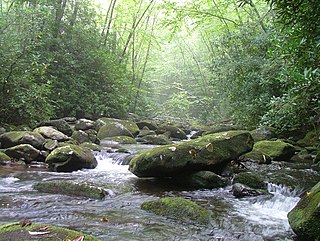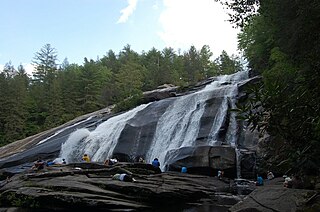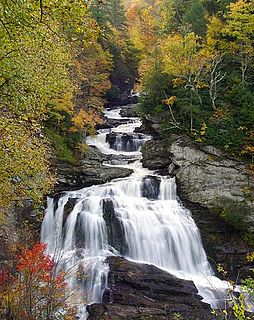
The Cherokee National Forest is a large National Forest created on June 14, 1920 and managed by the U.S. Forest Service and encompassing some 655,598 acres (2,653.11 km2).

Pisgah National Forest is a National Forest in the Appalachian Mountains of western North Carolina. It is administered by the United States Forest Service, part of the United States Department of Agriculture. The Pisgah National Forest is completely contained within the state of North Carolina. The forest is managed together with the other three North Carolina National Forests from common headquarters in Asheville, North Carolina. There are local ranger district offices located in Pisgah Forest, Mars Hill, and Nebo.

DuPont State Recreational Forest, commonly known as DuPont Forest, is a 10,473-acre (42.38 km2) state forest, located in Henderson and Transylvania counties of North Carolina. The name originates from the fact that the DuPont company arranged the sale of the original tract to the state. Adjacent tracts have since been purchased and added to the state forest. Portions of the forest formerly contained a manufacturing facility for the production of X-ray film. The forest was used to shoot scenes from the 1992 film The Last of the Mohicans as well as the 2012 box office hit The Hunger Games. On February 12, 2019, the forest added 402 acres (1.63 km2) from Conserving Carolina, part of a section called the Continental Divide Tract that connects with other public lands. 314 more acres will be added to the forest by the end of 2019.

The Nantahala National Forest, established in 1920, is a national forest located in the American state of North Carolina. The word "Nantahala" is a Cherokee word meaning "Land of the Noonday Sun." The name is appropriate as, in some spots, the sun only reaches the floors of the deep gorges of the forest when high overhead at midday. The Spanish Conquistador Hernando de Soto explored the area in 1540, as did William Bartram in the 18th century. The Nantahala River flows through the Nantahala National Forest.

Ellicott Rock Wilderness is managed by the United States Forest Service and is part of the National Wilderness Preservation System. It was first designated by Congress in 1975 with the Eastern Wilderness Act. The majority of this land lays in South Carolina. Additional lands were added to Ellicott Rock Wilderness in 1984 with the passing of the North Carolina Wilderness Act and the Georgia Wilderness Act, today designated wilderness totals 8,274 acres (33.48 km2). Ellicott Rock Wilderness is the only wilderness that straddles three states, with boundaries located around the point at which Georgia, North Carolina, and South Carolina come together. Ellicott Rock Wilderness also spans three National Forests. Sumter National Forest in South Carolina is responsible for 2,859 acres (11.57 km2), receives the majority of recreation in the wilderness, and also acts as the lead manager of Ellicott Rock Wilderness. Nantahala National Forest in North Carolina is responsible for the majority of the wilderness at 3,394 acres (13.74 km2) and the Chattahoochee National Forest in Georgia manages 2,021 acres (8.18 km2) of wilderness. In 1979, Forest Service land was surveyed under the Roadless Area Review and Evaluation and 1,982 acres (8.02 km2) adjacent to the existing wilderness were classified as Roadless National Forest System land, named Ellicott Rock Extension. The Andrew Pickens Ranger district on the Sumter National Forest recommended the Ellicott Rock Extension as wilderness in 1995 in their Resource Management Plan. In June of 2017 during a land management plan revision, the Nantahala Ranger District on the Nantahala National Forest added 824 acres (3.33 km2) of proposed wilderness, currently called Ellicott Rock West Extension.

The Welaka State Forest is in the U.S. state of Florida. The 2,287-acre (9 km2) forest is located in North Central Florida, upstream from Welaka on the eastern bank of the St. Johns River. Welaka State Forest is adjacent to the Mount Royal site discussed by William Bartram in chapter 4 of Bartram's Travels.

Bladen Lakes State Forest (BLSF) is a North Carolina state forest near Elizabethtown, North Carolina. It is managed by the North Carolina Forest Service. Covering about 32,950 acres (13,330 ha), it is the largest state owned forest in North Carolina. Bladen Lakes comprises three parcels of land and has a total of eight compartments. Adjoining the forest are Turnbull Creek Educational State Forest, Jones Lake State Park and Singletary Lake State Park. The vast majority of the forest is in the Game Lands Program, which is administered by the North Carolina Wildlife Resources Commission. There are several safety zones where hunting is prohibited or restricted.

Clemmons Educational State Forest (CESF) is a 825-acre (3.34 km2) North Carolina State Forest in Clayton. It is North Carolina's first educational state forest, and it is operated by the North Carolina Forest Service. The site features self-guided nature trails with audio exhibit stations, the Forestry Exhibit Center with interactive exhibits about the ecology of forests, soil, water, wildlife and the state's cultural history.

Jordan Lake Educational State Forest (JLESF) is a 900-acre (3.6 km2) North Carolina State Forest near Apex, North Carolina. It is located beside the over 46,768 acre (186 km²) Jordan Lake.

Holmes Educational State Forest (HESF) is a 235-acre (0.95 km2) state forest, located in Henderson County, North Carolina. It is near the much larger DuPont State Recreational Forest, which is responsible for its management. The forest is in the Blue Ridge Mountains, and it has rugged terrain with a mixture of hardwood forest, rhododendron, and flame azalea.

Mountain Island Educational State Forest (MIESF) is a 2,000-acre (8.1 km2) North Carolina State Forest in Mount Holly, North Carolina.

Rendezvous Mountain Educational State Forest (RMESF) is a 3,316-acre (13.42 km2) North Carolina State Forest in Purlear, North Carolina.

Turnbull Creek Educational State Forest (TCESF) is a 890-acre (3.6 km2) North Carolina State Forest in Elizabethtown, North Carolina. It is the only educational state forest located in North Carolina's coastal plain. Jones Lake State Park is adjacent to the forest, and both are surrounded by Bladen Lakes State Forest. The forest's primary purpose is public education of forestry practices.
The North Carolina Forest Service, formerly known as the North Carolina Division of Forest Resources is a North Carolina state government agency responsible for providing land management assistance to landowners. The agencies priority responsibility is for wildland fire control on all state and privately owned land in North Carolina, United States. The Service was a Division of the N.C. Department of Environment and Natural Resources until July 2011 and is now part of the North Carolina Department of Agriculture and Consumer Services.

Dan Forest is an American businessman and politician who currently serves as the 34th lieutenant governor of North Carolina, since 2013. A Republican, Forest is an architect by trade. Prior to his run for lieutenant governor, he was the Senior Partner and Office President of North Carolina's largest architectural firm, Little Diversified Architectural Consulting. Forest lives in Wake County with his wife, Alice, and his four children.

The NC State–Wake Forest rivalry is a series of athletic contests between in-state rivals, the North Carolina State University Wolfpack and the Wake Forest University Demon Deacons. The first game was played in 1895 between the two institutions. Wake Forest was originally located in Wake Forest, North Carolina until it moved its campus across the state of North Carolina to Winston-Salem, North Carolina in 1956. The two universities are members of the Atlantic Coast Conference, where they meet every year in football due to being aligned in the Atlantic Division. The schools play each other twice in basketball every season, due to being primary partners.
















